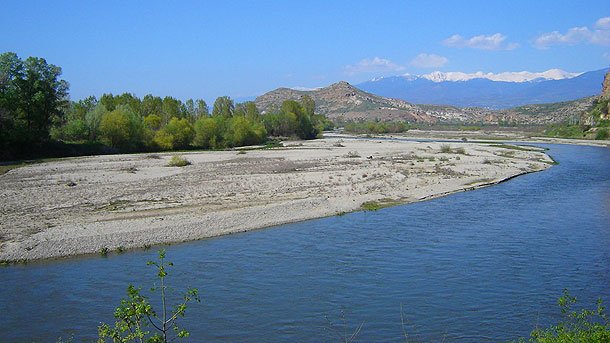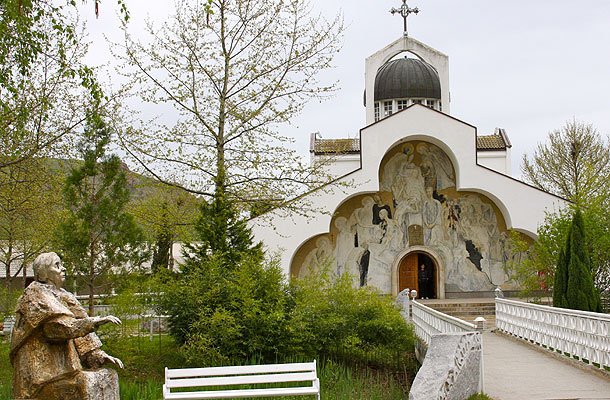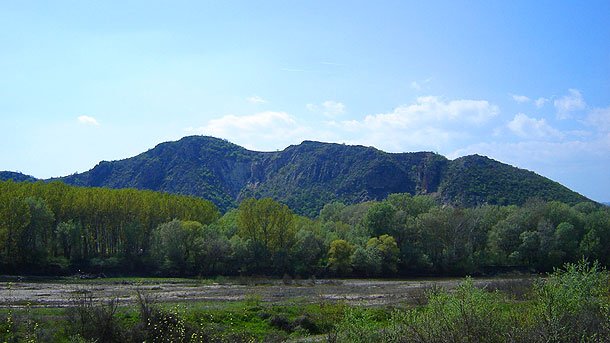Rupite locality is situated in Southwestern Bulgaria on the land of the homonymous mountain village, at the foot of a small upland. The local people called this hill Kozhuh Planina (fur-coat mountain), because its outlines really resemble a fur-coat. The newly built Saint Petka Bulgarska church also lies in this locality. Healing mineral water springs at several places there. Its natural temperature reaches 75°C. The air is clean there and the nature is magnificent in all four seasons.

© Photo: imagesfrombulgaria.com
The hot thermal springs, the beauty and calmness constantly attract many tourists to this picturesque Bulgarian land. However, the real power of attraction is hidden in the connection of prophet Vanga with this place. When she was still alive, she claimed that the Rupite locality and Kozhuh Mountain hide great secrets from the remote past. She used to say that there is a special energy in these places which helps people. Grandma Vanga, as people used to call this great Bulgarian woman built a small house at this place. There she was meeting many Bulgarians and foreigners. She had thousands of worshipers who relied on her abilities to foresee the future and give them health advices and tips about crucial moments in life.

© Photo: BGNES
The Saint Petka Bulgarska temple was built with money donated by Grandma Vanga in the beginning of the 1990’s. The project was developed by architects Bogdan Tomalevski and Lozan Lozanov. The icons at the iconostasis were created by the renowned Bulgarian artist Svetlin Rusev who was a close friend of prophet Vanga. The images created by Rusev differ a lot to the canonical ones. This caused many disputes among the believers and led to their disapproval by the Bulgarian Holy Synod. The priests refused for a long time to visit this temple. Grandma Vanga herself made huge efforts to calm people down with the arguments that this place was giving big energy and hope to people and this was the most important thing for her. In 1994 the church was consecrated with a solemn liturgy and the number of its visitors has been constantly growing sine then. Many of the visitors donate small amounts to the temple and lay flowers on the tomb of prophet Vanga which lies in the church yard. On August 15, when Bulgaria marks the Assumption feast, a traditional fair is held in the Rupite locality to the sound of folklore music performed by local singers and instrumentalists.

© Photo: bg.wikipedia.org
Rupite locality was formed after the eruption of a volcano which died out some 1 million years ago. Thus, the Kozhuh upland was formed. There are ruins of some of the biggest towns along the Struma River Valley. According to the sign which was discovered there, the town of Heraklea Syntica lied there. This town was mentioned many times in the ancient historical sources. It existed from the 4th century BC until the 6th century AD. Later another settlement emerged on this place which was mentioned in the tax registers of the Ottoman Empire. The earliest documents of this type date back to the 15th century. The Bulgarian historian Georgi Strezov mentioned this village in 1891. In his ethnographic and historical researches he described its position very precisely. According to this renowned Bulgarian historian, the local population used to call this mountain Kralimarkovska. People told legends about the mythical hero Krali Marko who used the caves as coverts.

© Photo: imagesfrombulgaria.com
In 1962 Kozhuh Mountain was declared natural landmark. The surrounding area attracts the fans of the eco-tourism. Here, they can see many rare animal and plant species. Some of them were listed in the Bulgarian Red Book. The climate in this area is semi-Mediterranean which provides perfect conditions for the growth of many animal and plant species who love mild weather. There is also an ornithology station where the migration of the birds of passage is studied.

© Photo: imagesfrombulgaria.com
There are several historical and natural landmarks in this part of Bulgaria which are worth seeing and are often included in the common tourist routes. Those who are keen on the esoteric experiences can travel a little bit further to the south to the small village of Zlatolist where Reverend Stoyna used to live. She was also a prophet who lost her eyesight when she was a little child. She lived on her own in the Saint George Church. She was helping people with her advices and was an example of modesty. Just like Grandma Vanga, which according to beliefs, was sent to guide and protect people. The smallest town in Bulgaria Melnik is also in a close proximity. It is famous with its natural phenomena and wonderful architecture which dates back to the National Revival period. The Rozhen Monastery and the resort town of Sandanski are also situated in this region. This is the area of Pirin Mountain and some other smaller mountains. The beautiful natural scenes can be seen everywhere in this wonderful part of Bulgaria.
English version: Kostadin Atanasov.
In its centuries-old history, the Etropole Monastery "Holy Trinity", also called "Varovitets", has been preserving valuable pages decorated by skilled artists. Here hundreds of years ago, one of the most productive literary schools in Bulgarian..
Cape Kaliakra is one of the most picturesque places along Bulgaria’s Black Sea coast. The narrow rocky peninsula cuts 2 kilometers through the sea. Its steep slopes are 60-70 meters high. The waves have cut deep niches and caves..
As a result of glacial erosion during the Quaternary era, clusters of lakes were formed in the higher reaches of Rila Mountain, an essential element of the landscape. The string of the seven lakes of Rila is the longest, most scenic and most..

+359 2 9336 661
